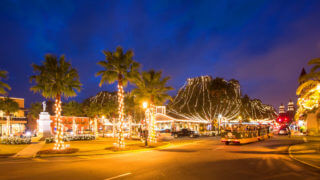Flagler College
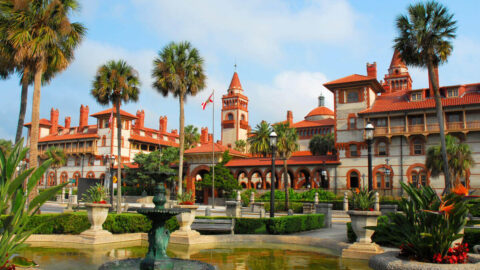
Explore the History and Beauty of Flagler College
In the center of St. Augustine’s historic district, Flagler College stands as one of the city’s most impressive and admired landmarks. Originally built as a luxury resort during the Gilded Age, the building is now home to a respected liberal arts college and a popular stop for visitors exploring the area.
The architecture alone draws people in. With its soaring towers, detailed stonework and courtyard fountain, the campus offers a glimpse into a time when elegance and innovation shaped the city’s future. Inside, guided tours take guests through spaces once reserved for high-society travelers and now are used as classrooms and gathering places for students.
Relive history and enjoy Transportainment®
A visit to Flagler College is more than a walk through a beautiful building. It’s a chance to experience the vision of Henry Flagler, a man who helped shape modern Florida and left behind one of the most iconic structures in St. Augustine.
What Is the History of Flagler College?
The Vision of Henry Flagler
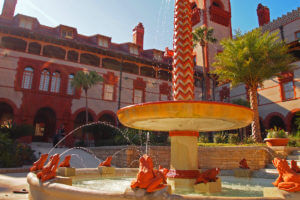 The story of Flagler College begins with Henry Flagler, a visionary businessman who played a key role in shaping modern Florida. As a co-founder of Standard Oil, Flagler had the resources and ambition to bring luxury and tourism to Florida’s east coast. In the late 1800s, he set his sights on St. Augustine, already a popular destination for travelers but lacking modern accommodations. His answer was the Ponce de Leon Hotel, a resort that would rival the finest in Europe.
The story of Flagler College begins with Henry Flagler, a visionary businessman who played a key role in shaping modern Florida. As a co-founder of Standard Oil, Flagler had the resources and ambition to bring luxury and tourism to Florida’s east coast. In the late 1800s, he set his sights on St. Augustine, already a popular destination for travelers but lacking modern accommodations. His answer was the Ponce de Leon Hotel, a resort that would rival the finest in Europe.
Construction began in 1885 and involved innovative techniques for the time, including poured concrete and state-of-the-art plumbing. Flagler brought in some of the era’s most celebrated minds. Thomas Edison oversaw the hotel’s electrical systems, and Louis Comfort Tiffany designed the stained glass and interior elements. The hotel opened in 1888 to great acclaim and quickly became a favorite among wealthy Northerners seeking refuge from winter.
From Resort to College
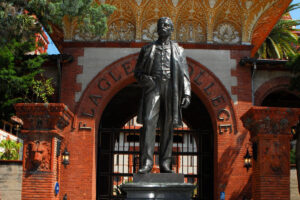 For decades, the Ponce de León Hotel remained one of the most prestigious resorts in the South. Presidents, authors and socialites walked its marble floors and dined beneath grand chandeliers. As times changed, however, so did the city’s needs. In 1968, after the hotel closed its doors, the building found a new purpose as Flagler College, a private liberal arts institution that continues to thrive today.
For decades, the Ponce de León Hotel remained one of the most prestigious resorts in the South. Presidents, authors and socialites walked its marble floors and dined beneath grand chandeliers. As times changed, however, so did the city’s needs. In 1968, after the hotel closed its doors, the building found a new purpose as Flagler College, a private liberal arts institution that continues to thrive today.
Rather than strip the property of its character, the founders of the college preserved many original features. The majestic lobby with its domed ceiling still greets visitors. The once-private dining room, filled with hand-painted murals and rich woodwork, now serves as a communal space for students. Even the student dorms are located within what were once high-end guest suites, giving residents a one-of-a-kind campus experience. Every effort was made to maintain the architectural integrity of the building while adapting it for academic use.
A Living Legacy
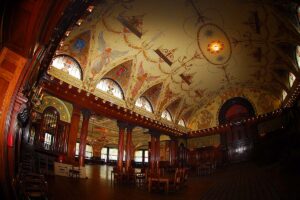
The college plays an active role in preserving this history while looking to the future. Students study in halls filled with stories, and the campus serves as a bridge between St. Augustine’s past and present. For those interested in both history and design, a visit to Flagler College offers a rare opportunity to walk through a space where time, talent and imagination come together in every detail.
Know Before You Go
Flagler College is located at 74 King Street in the heart of St. Augustine’s historic district. While the college is an active campus, it also welcomes visitors who want to explore its architectural beauty and rich history. Guided tours are available daily and begin inside the main entrance, just past the wrought-iron gates. Tickets can be purchased online or at the college, and tours often fill up during weekends and holidays, so arriving early or booking in advance is a good idea.
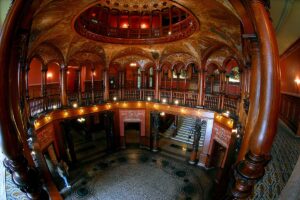
Parking in the historic district can be limited. Public garages and nearby metered spots are available, but spots may fill quickly during peak seasons. Comfortable shoes are recommended, as much of the walking takes place on tile or brick.
If you’re planning to visit multiple sites in one day, Old Town Trolley Tours offers a convenient way to get around. The trolley includes a stop near Flagler College and provides a relaxing narrated ride through the city’s most popular landmarks. It’s a great option for anyone who wants to see more of St. Augustine while keeping things stress-free.
What Are Some Things To Do Nearby Flagler College?
Spending time at Flagler College places you in the center of one of the most walkable and historically rich areas in St. Augustine. Once you’ve explored the college, there are plenty of nearby attractions to fill the rest of your day.
 Lightner Museum
Lightner Museum
Just across the street from Flagler College, the Lightner Museum is housed in the former Alcazar Hotel, another landmark built by Henry Flagler. Inside, visitors can explore an impressive collection of 19th-century art, antiques, and curiosities. Exhibits include everything from decorative glassware and musical instruments to historic furniture. The building itself is part of the experience, with sweeping courtyards and grand architectural details that make it one of the most photographed museums in the city.
 Villa Zorayda Museum
Villa Zorayda Museum
A short walk from the college brings you to the Villa Zorayda Museum, known for its striking design inspired by the Alhambra Palace in Spain. Built in the late 1800s, this former private residence now showcases unique furnishings, artifacts, and art collected from around the world. The museum offers self-guided audio tours that help bring the history of the home and its original owner to life.
 St. George Street
St. George Street
Just a few blocks away, St. George Street is one of the most popular areas to explore on foot. This pedestrian-only thoroughfare is lined with historic buildings, local boutiques, snack stands and sit-down restaurants. It’s also home to several notable sites like the Oldest Wooden School House and the Colonial Quarter. For visitors interested in shopping, food and local culture, it’s a great way to continue your day after visiting Flagler College.
 Plaza de la Constitución
Plaza de la Constitución
Located nearby, the Plaza de la Constitución is the oldest public space in the United States. Framed by large oak trees and historic buildings, the plaza is a peaceful place to take a break, enjoy some shade or catch a live event. Throughout the year, the plaza hosts concerts, holiday celebrations and art fairs, making it a gathering spot for both locals and visitors.
 Old Town Trolley Tours®
Old Town Trolley Tours®
To see more of the city without having to drive or search for parking, hop on Old Town Trolley Tours. The trolley has a convenient stop near Flagler College and offers a fully narrated ride through the historic district and beyond. It’s a relaxing way to connect to more of the city’s top attractions while learning about St. Augustine’s past from knowledgeable guides.
Conclusion
A visit to Flagler College is one of the most rewarding experiences in St. Augustine. Set in the heart of the historic district, this former luxury hotel turned liberal arts college offers more than just beautiful architecture. It provides a rare opportunity to walk through a space where Florida’s early tourism boom, Gilded Age design and modern education intersect.
From the moment you step into the rotunda, you’re surrounded by craftsmanship and detail that have been preserved for over a century. Guided tours bring the building’s rich past to life while highlighting the creative minds who helped shape it, from Henry Flagler to Thomas Edison and Louis Comfort Tiffany. Every tile, stained-glass panel and mural shares a piece of the story.
With so many historic sites nearby, it’s easy to pair a tour of Flagler College with other St. Augustine landmarks. The area is pedestrian-friendly, and Old Town Trolley Tours makes it even easier to get from place to place while enjoying live narration along the way. For history lovers, architecture buffs and curious travelers alike, this stop adds depth and beauty to any visit.
FAQs
What makes Flagler College a must-visit for tourists?
Flagler College is not just an academic institution — it’s a masterpiece of Gilded Age architecture and a vital part of St. Augustine’s history. Once the luxurious Ponce de Leon Hotel, the building showcases intricate stonework, arched ceilings, hand-painted murals and one of the largest collections of original Tiffany stained glass in the world. For visitors, the guided tour offers a rare glimpse into the opulence of the past, along with stories about the visionaries who made it possible. The college’s ongoing role as a place of learning adds a living layer to its history, making it a meaningful stop for anyone exploring the city.
What are the historical highlights of Flagler College worth seeing?
Some of the most impressive features of Flagler College include the ornate dining hall with its stunning frescoes, the rotunda with its hand-painted dome and the preserved guest rooms now used as student dorms. The architecture reflects Spanish Renaissance influences, and many of the original design elements have been carefully maintained. Highlights also include the carved woodwork, marble floors and decorative ironwork found throughout the building. These elements tell the story of a time when no detail was overlooked in creating one of the most luxurious resorts of its era.
Can I walk around Flagler College?
Yes, Flagler College offers guided tours that take you through many of its most notable spaces. While parts of the campus are reserved for students, the tours provide public access to key areas, including the grand lobby, courtyard and historic dining room. Walking around the exterior is also encouraged, as the campus grounds are beautifully maintained and full of architectural details to admire. Visitors should wear comfortable shoes and allow extra time to explore nearby attractions before or after the tour.
Do I need to book a tour in advance?
It’s a good idea to book your tour ahead of time, especially during weekends, holidays or school breaks when the college sees more foot traffic. Advance reservations ensure you get your preferred time slot and avoid long waits. Tours can be booked online through the college’s website or at the ticket office on-site. Same-day tickets are sometimes available but can fill up quickly during peak travel seasons.
How long does a tour of Flagler College take?
Most guided tours last approximately one hour and cover the college’s most historic and visually impressive spaces. In addition to learning about the architecture and design, guests hear stories about the building’s transition from hotel to college and its role in the broader history of St. Augustine. Some visitors choose to stay longer to take photos, enjoy the gardens or visit nearby museums and shops after the tour ends.
What is the best time of day to visit Flagler College?
Mid-morning through early afternoon is often the best window for visiting. The natural light at this time of day enhances the stained glass and painted ceilings inside the building, making them easier to appreciate. The earlier part of the day also tends to be less crowded, which gives you more time to enjoy the tour at a relaxed pace. Planning your visit early also leaves time to explore other nearby attractions or enjoy lunch in the historic district.
Is Flagler College a good stop for families with kids?
Yes, families are welcome, and older children often find the experience interesting thanks to the grand visuals and engaging stories shared during the tour. The historical context, colorful interiors, and chance to explore a real college campus give younger visitors something unique to remember. That said, families with younger children may want to consider their attention span, as most of the experience involves standing and listening to a guide.
Can I visit Flagler College even if I’m not on a tour?
Access to the interior of Flagler College is limited to those on official tours, but the grounds and surrounding architecture can be admired without a ticket. Guests are welcome to explore the exterior and take photographs of the façade, courtyard and landscaping. If you have time, joining the tour is highly recommended, as it provides valuable insights and access to areas that are not open to the general public.

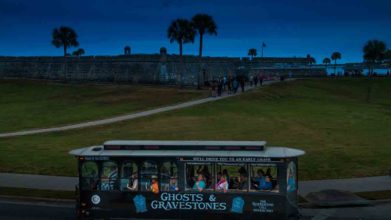
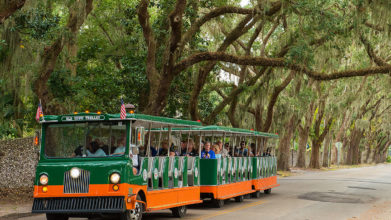
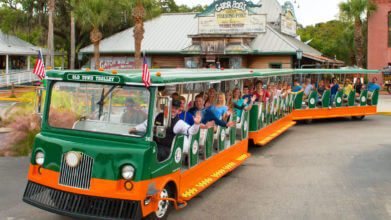

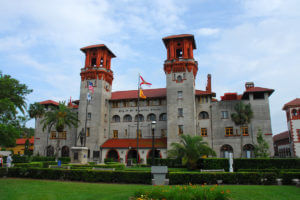 Lightner Museum
Lightner Museum Villa Zorayda Museum
Villa Zorayda Museum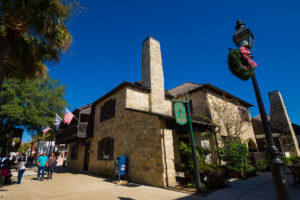 St. George Street
St. George Street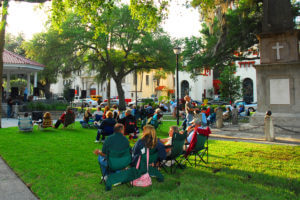 Plaza de la Constitución
Plaza de la Constitución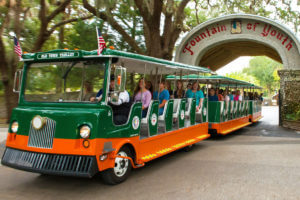 Old Town Trolley Tours®
Old Town Trolley Tours®